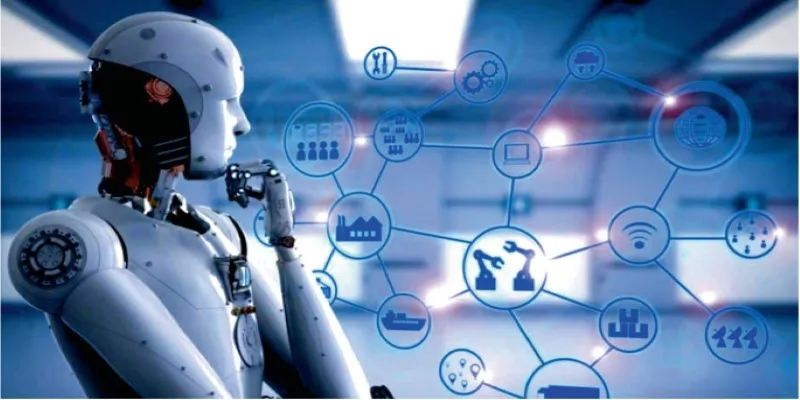Autonomous robots are revolutionizing operations across a wide range of enterprises. Companies increasingly use robotic solutions to simplify tasks, increase output, and reduce operational expenses. These fast and precise machines are transforming work environments, from offices to warehouses. Businesses today depend on autonomous robots for manufacturing , shipping, and even customer service.
As technology develops, the trend of corporate automation, including robotics, is gaining momentum. Intelligent systems now manage repetitive tasks more efficiently than human effort, providing real-time data, consistent performance, and scalable processes. Using robotic solutions helps businesses remain competitive in the rapidly advancing digital era. Autonomous robots are at the forefront of enterprise transformation.

Autonomous Robots in Manufacturing
The manufacturing sector was among the first to integrate autonomous robots. Today, robots accurately handle repetitive assembly line duties, reducing human error and significantly increasing efficiency. Machines operate without breaks, thereby accelerating output. AI-driven robotic arms manage complex tasks by analyzing and adjusting data in real time. Lower labor costs and reliable productivity benefit businesses.
Moreover, robots support predictive maintenance by preventing breakdowns and detecting machine wear. As adaptable systems, they help manufacturers reduce defects and improve quality control. By taking on hazardous tasks, robots contribute to safer work environments, allowing human employees to focus on high-skill, creative tasks. Automation enhances global market competitiveness, transforming both large-scale operations and small businesses. Autonomous robotics is now a core strategy in production.
Enhancing Warehouse Logistics and Inventory Management
Autonomous robots play a crucial role in warehouse logistics. These devices efficiently transport products, minimizing delays. Drones and autonomous guided vehicles (AGVs) assist in monitoring inventory, reducing human error and preventing lost goods. Smart robots expedite distribution by rapidly picking and sorting items, enhancing customer satisfaction and minimizing shipping delays. Robots work seamlessly with warehouse management systems, enabling real-time monitoring and optimization of operations.
Automated systems optimize storage capacity by managing shelf placement and determining the best routes for quick access. Robot-generated data analytics guide demand forecasts and supply chain decisions. Robots operate around the clock, even in low light, effectively managing peak demand times and labor shortages. Robotic systems enhance scalability, accuracy, safety, and efficiency, making enterprise automation vital to modern supply chain success. Companies continue investing in smarter warehouse systems.
Customer Service and Frontline Applications
Service robots are increasingly supporting customer-facing roles in airports, hotels, and banks. They handle simple inquiries, check-ins, and information searches, improving the service experience and reducing wait times. AI enables robots to respond naturally and comprehend user input effectively. Facial recognition allows robots to deliver personalized assistance, providing round- the-clock service without human fatigue.
Robots easily handle multilingual communication and support accessibility features for people with special needs. In retail stores, robots suggest products based on customer behavior and relay real-time feedback to management. By freeing frontline workers from monotonous tasks, robots enable them to focus on complex interactions. Under pressure, robots maintain consistency, eliminating mistakes and mood-based variances. Technological innovation helps companies enhance their brand image.

Facility Maintenance and Environmental Monitoring
Robots are instrumental in managing office and building operations. Cleaning robots are programmed to sanitize spaces efficiently, navigating around obstacles and following sophisticated maps to maintain high hygiene standards with minimal effort. Security robots monitor buildings and alert staff to potential intrusions or unusual activities. Maintenance robots detect early signs of HVAC or plumbing issues, allowing for predictive repairs that reduce costs and downtime. Environmental sensors track temperature and air quality.
Offices can automatically adjust conditions to ensure staff comfort. Robots document energy consumption, enabling sustainability and waste reduction. Continuous monitoring results in smarter and safer facilities. Robots operate in hazardous areas like basements or rooftops, significantly reducing human exposure to danger. Compliance with safety regulations becomes more manageable. Facility robots are scalable for both small offices and large campuses, offering affordable and improved maintenance solutions. Robotic enterprise automation ensures superior control over internal systems.
Autonomous Robots in Data Centers and IT Operations
Modern data centers deploy robots to manage critical infrastructure tasks. Robots handle tasks like wire management and hardware installation, which require precision and are now fully automated. Faster fault detection reduces downtime, while thermal imaging helps robots identify overheating equipment, raising alerts before damage occurs. IT personnel receive alerts for quick response, and robotic systems handle repairs to maintain uninterrupted operations.
Data centers use AI-driven robots to monitor servers, navigating in low light and confined spaces to improve efficiency. For remote troubleshooting, robots provide records and video streams, ensuring compliance and security. Only programmed robots access secure areas, supporting constant service delivery and disaster recovery strategies. Robots examine system responses and assist in simulating scenarios. In IT and logistics, autonomous robots offer unparalleled uptime, helping companies save costs and better protect digital infrastructure.
Conclusion
Autonomous robots are revolutionizing business processes across multiple industries, from customer service desks to manufacturing lines. To stay competitive and efficient, companies are embracing enterprise automation, including robotics. The primary advantages include task accuracy and real-time decision-making. Robotic solutions for business reduce human error, enhance worker safety, and drive growth. In logistics, IT, and service sectors, autonomous robots are shaping the future of corporate innovation. Businesses that adopt robotic technologies become more agile and resilient. As robotic systems continue to evolve, their role in business will become increasingly vital and transformative.
 zfn9
zfn9






















